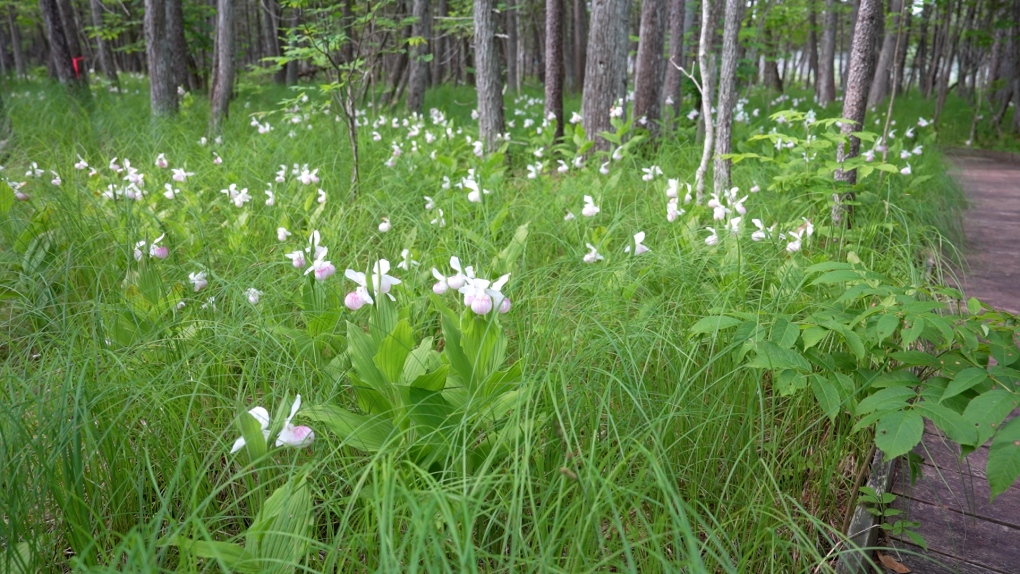This eastern Ontario conservation area is home to the largest colony of lady's slipper orchids - and they're in bloom
Not far from Ottawa, there are thousands of wild orchids that bloom just once a year, and you can visit along a boardwalk.
If you're looking for a sight to see this week, the showy lady's slipper orchids are in full bloom at a conservation area in eastern Ontario.
The Purdon Conservation Area is home to the largest colony of the plant in Canada.
 The Purdon Conservation Area is about a 30-minute drive northwest of Perth, Ont.
The Purdon Conservation Area is about a 30-minute drive northwest of Perth, Ont.
"Pretty spectacular," says Joyce Bielby, from Vancouver Island, who is visiting family. For her, this was a must-see.
"Many years ago, I saw it and I thought, it's been a long time. I'd like to make a return trip," she tells CTV News Ottawa.
Peak bloom is generally around Father's Day, and the show that nature puts on is a hit with visitors.
"They're the star of the show at Purdon every year for about three weeks," says Scott Lawryk, Mississippi Valley Conservation Authority Property Manager.
"Within the conservation area here, we have between 6,000 and 7,000 lady's slipper orchids," he says.
Why are there so many in one place?
Lawryk says the plants need very specific conditions to thrive.
"It's the moisture in the soil," he says. "There's certain kind of soil compounds that help them grow. And also they tend to enjoy the combination of other plants to be able to help them thrive as a colony."
 The Purdon Conservation Area in the Lanark Highlands is home to Canada's largest colony of showy lady's slipper orchids in Canada. (Peter Szperling/CTV News Ottawa)
The Purdon Conservation Area in the Lanark Highlands is home to Canada's largest colony of showy lady's slipper orchids in Canada. (Peter Szperling/CTV News Ottawa)
An elevated 450-metre long boardwalk keeps your feet dry, and the orchids safe from getting trampled or touched.
Lawryk says thousands come to see the plants in bloom each year.
"I can see why they are called lady's slippers because they look like wee shoes," one visitor told CTV News Ottawa.
Parking and admission is free. Donations are accepted. If you're planning to visit, you'd best hurry – the bloom is almost done for the year.
You can check the status of the bloom on the official page for the conservation area.
CTVNews.ca Top Stories

Mark Carney reaches out to dozens of Liberal MPs ahead of potential leadership campaign
Mark Carney, the former Bank of Canada and Bank of England governor, is actively considering running in a potential Liberal party leadership race should Justin Trudeau resign, sources tell CTV News.
Here’s the latest on this weekend's winter storms in Canada
From snow, to high winds, to extreme cold, much of Canada is under a severe weather alert this weekend. Here's what to expect in your region.
This Canadian couple has been to 195 countries. Here's what they learned on their eight-year journey
Masha and Robert Glanville, a Canadian couple, sold everything they owned to travel the world full-time. With over 195 countries visited, they focus on mindful, eco-friendly travel and giving back. Here’s what they had to say about their global journey.
Montreal arson squad investigating after commercial space fire bombed
The Montreal police’s (SPVM) arson squad is investigating after a vacant commercial space was fire bombed on Saturday night.
WATCH Woman critically injured in explosive Ottawa crash caught on camera
Dashcam footage sent to CTV News shows a vehicle travelling at a high rate of speed in the wrong direction before striking and damaging a hydro pole.
Trump appears with Italian Prime Minister Meloni at his Florida club
U.S. President-elect Donald Trump made an appearance Saturday with Italian Prime Minister Giorgia Meloni, who was visiting his Mar-a-Lago club.
'I gave them a call, they didn't pick up': Canadian furniture store appears to have gone out of business
Canadian furniture company Wazo Furniture, which has locations in Toronto and Montreal, appears to have gone out of business. CTV News Toronto has been hearing from customers who were shocked to find out after paying in advance for orders over the past few months.
B.C. man ordered to pay damages for smashing Smart car window during road rage incident
A man who smashed the window of a woman’s Smart car during a road rage incident with a former co-worker has been ordered to pay $1,245 in damages by the B.C. Civil Resolution Tribunal.
Hezbollah leader Nasrallah was killed last year inside the war operations room, aide says
Hezbollah leader Hassan Nasrallah was killed in an Israeli airstrike last year while inside the militant group's war operations room, according to new details Sunday disclosed by a senior Hezbollah official.


































